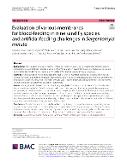Evaluation of various membranes for blood-feeding in nine sand fly species and artificial feeding challenges in Sergentomyia minuta

Author
Stejskalová, Markéta
da Costa, Lidiane Medeiros
Sant'Anna, Mauricio Roberto Viana
Publication date
2025Published in
Parasites & VectorsVolume / Issue
18 (1)ISBN / ISSN
ISSN: 1756-3305Metadata
Show full item recordCollections
This publication has a published version with DOI 10.1186/s13071-025-06729-8
Abstract
BackgroundWe evaluated various membranes for blood-feeding in nine sand fly species from different genera and subgenera. Most of these species are vectors of human-pathogenic Leishmania, whereas Sergentomyia minuta is a herpetophilic sand fly species and a proven vector of Leishmania (Sauroleishmania) tarentolae.MethodsFemale sand flies were offered blood through a range of membranes (chicken, reptilian, and frog skin; synthetic collagen; pig intestine; and duck foot webbing). Two feeding systems (glass feeder, Hemotek) and different blood sources (human, ovine, avian, and reptilian) were used. Feeding trials were conducted under varying thermal and light conditions to determine the optimal parameters.ResultsAmong the 4950 female S. minuta tested, only a negligible fraction took a blood meal: 2% of the females fed on avian blood, and 0.2% of the females fed on human blood. In eight other species, the chicken membrane was generally more effective than synthetic membranes or pig intestines. For example, Phlebotomus duboscqi refused synthetic membranes, while Lutzomyia longipalpis and P. perniciosus avoided both synthetic membranes and pig intestines. The most effective membrane was duck foot webbing, with four species feeding more readily through it than through the chicken membrane. Additionally, applying coagulated blood plasma to the outer surface of chicken or synthetic membranes significantly increased feeding rates.ConclusionsFemale S. minuta did not reliably feed on blood through the tested membranes, preventing laboratory infection experiments from confirming their vector competence for human-pathogenic Leishmania. However, for future experimental infections of other sand fly species, duck foot webbing has emerged as an effective membrane, and the application of blood plasma to the exterior of membranes may increase the feeding rates.
Keywords
<italic>Sergentomyia minuta</italic>, <italic>Phlebotomus</italic>, <italic>Lutzomyia</italic>, Vector competence, Artificial feeding, <italic>Leishmania</italic>,
Permanent link
https://hdl.handle.net/20.500.14178/3091License
Full text of this result is licensed under: Creative Commons Uveďte původ 4.0 International







